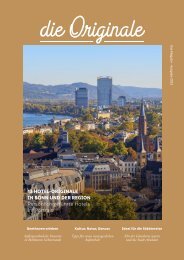LUXAIR_LUXiClub_So12 ls
p o
p
o
You also want an ePaper? Increase the reach of your titles
YUMPU automatically turns print PDFs into web optimized ePapers that Google loves.
Number 43, Fall 2002
cartographic perspectives
Irony,” which was published six years before he wrote “Mappemounde”
(1939, in Birney 1985, 56-59). It may, therefore, have been his intent to
contrast “Mappemounde” ironically with one of its inspirations: “To
Rosemounde” couldn’t differ more from Birney’s melancholy, heavily
stressed verses.
Birney clearly chose the word mappemounde for its cartographic implications.
To use the words of the Chaucerian editor, Walter Skeat, Rosemounde
is the shrine of all beauty “as far as the map of the world extends”
(Skeat [1899] 1952, 549). Writing in the second half of the fourteenth
century, Chaucer imagined the earth that was portrayed in contemporary
world maps—an island “cercled” by the ocean/sea (cf. Tomasch 1992).
Historians call such maps mappaemundi, “maps of the world,” which is the
plural form of the medieval Latin mappa mundi (du Cange 1954, 5:255). Approximately
1100 mappaemundi survive of those made in Europe between
the fifth and the mid-fifteenth centuries. Some are little more than sketches
of a “T-O” shaped world: they show the earth as an ocean-embraced circle
of land (“O”) divided by the cross-like intersection (“T”) of the Mediterranean
Sea with the Don (Tanais) and Nile rivers forming the boundaries of
the three known continents: Asia, Africa, and Europe. Other mappaemundi
are adorned with hundreds of names, pictures, and legends. Still others
portray the earth divided into five (later seven) zones, with frigid polar
regions, temperate zones, and a central uninhabitable belt at the equator
known as the perusta zona (“the burnt up zone”). Most represent the world
as a Christian allegory, featuring prominent figures from the Old and New
Testaments alongside characters from classical mythology and ethnographies.
Although gradually modified by trade and travel, mappaemundi
continued to superimpose Christian theological views about space upon
Greco-Roman conceptions of geography. Even during Chaucer’s time,
in the late Middle Ages, many world maps resembled those made in the
thirteenth century and earlier (Harvey 1991, 37; Delano-Smith and Kain
1999, 15-22).
“Writing in the second half of
the fourteenth century, Chaucer
imagined the earth that was
portrayed in contemporary
world maps—an island “cercled”
by the ocean/sea.”
Birney’s “Mappemounde,” Mappaemundi, and Early English World
Maps
Birney displays his familiarity with mappaemundi throughout “Mappemounde.”
5 His reference to “scribe” reminds us that the vast majority of
mappaemundi illustrated the Bibles, psalters, and encyclopedic treatises
produced in cathedral communities and monastic scriptoria (“writingrooms”).
Monks, trained as scribes, copied these texts by hand and drew
the accompanying maps (Woodward 1987, 286 and 324; Campbell 1987,
428-29). Birney’s emphasis upon the cardinal directions reflects their
prominence on mappaemundi. Although zonal mappaemundi had varying
orientations, most medieval world maps feature east at the top because
the Bible locates the earthly paradise there (Genesis 2:8; Isidore of Seville,
Etymologies 14.3.1-2). “East” represents man’s early innocence and the
promise of everlasting life in Heaven. “West,” by contrast, symbolizes the
world’s decay and the eternal damnation of sinners in the depths of Hell
(see below, and Baritz 1961). Birney’s nadders suggest the dragons lurking
in the west, below the world’s frame on the diminutive Psalter map, made
around 1300 (Figure 1, page 65). Though illustrating a book of Psalms, the
Psalter map is distinctly apocalyptic. It displays Christ above, in the east,
flanked by angels; below, in the west, two dragons represent Satan and
his emissaries. In “Mappemounde” Birney multiples the dragons, locating
them in the east and west, and calling them nadders, which means “devils”
as well as “serpents” or “dragons.”
“Birney displays his familiarity
with mappaemundi
throughout ‘Mappemounde.’”















